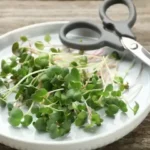Microgreens vs sprouts. Which is better? If you’re ready to take your microgreens skills to the next level yet still wondering about the differences between these very different vegetable growth stages, you’ve come to the right spot. There are some misconceptions that microgreens and sprouts are the same. In reality, there are some critical differences between the two, the main one being how they grow.
Sprouts are self-sufficient, germinate in water, and can grow without soil or nutrients. However, microgreens require soil or an alternative growing medium, like coco coir, to develop while needing more nutrients and attention than sprouts throughout their growing cycle. In addition, microgreens are larger than sprouts and exhibit deeper flavor profiles.

With both microgreens and sprouts offering numerous health benefits and flavors that can spice up your meals, it’s worth discovering their similarities and differences so you can grow them efficiently and consistently. Let’s compare microgreens and sprouts, so you know everything you need to get started.
Humble Highlights
- Save time by knowing the differences and similarities between microgreens and sprouts so you know what to grow and how to grow it right.
- Save money by learning how to fight against damaging mold and bacteria to save your crop and become a seasoned pro!
- Build your gardening skills by knowing which microgreens and sprouts are most nutritious so you can start growing them effectively from day one.
Microgreens vs. Sprouts Comparison Chart
A key difference between microgreens and sprouts is when they are harvested. Depending upon the variety, microgreens reach maturity from 1 to 3 weeks after sowing and achieve a growth stage where their ‘true’ leaves emerge from the plant stem. Sprouts only take about a week or less to grow and are harvested when only the cotyledons, or seed leaves, are present. Therefore, while you can consume the entire shoot, seed, and root of the sprout, you should only eat the leaves and stems of your microgreens.
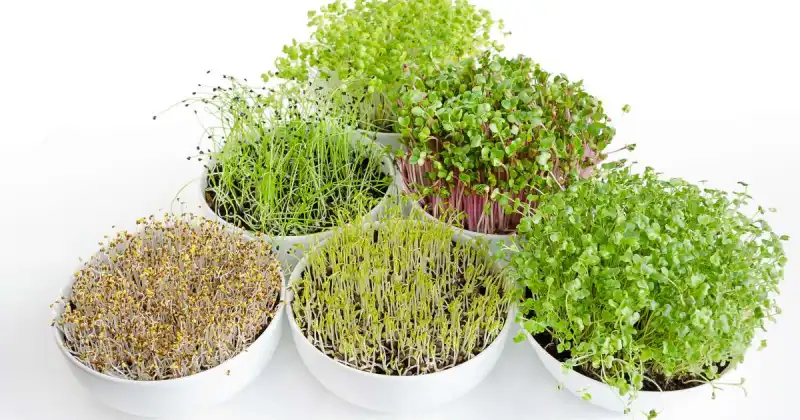
Before we look at the similarities and differences between microgreens and sprouts, the comparison chart below provides a general overview of each. 1
| Microgreens | Sprouts | |
| Typical Time Until Harvest | 7-20 Days | 3-5 Days |
| Required Growing Medium | Soil, Peat, Coco, Coir, Hydroponically | Water |
| Temperature Requirements | 65 to 75 degrees F | 70 to 85 degrees F |
| Main Nutrients | Nitrogen (N) Phosphorus (P) Potassium (K) Calcium (Ca) Sulfur (S) Magnesium (Mg) Carbon (C) Oxygen (O2) Hydrogen (H) | None – sprouts store nutrients in their seeds that are released into the water when germinating |
| Light Requirements | Plenty of sunlight for maximum growth potential | Dim, room, or no lighting necessary |
| Ventilation | Required | Not Required |
| Typical Growth Height | 3 to 7 inches | 1 to 3 inches |
| Appearance | Larger and leafy | Smaller and mainly stem with tiny leaves |
| Nutritional Content | Extremely nutrient-rich | Nutrient-rich but less than microgreens. Higher water content than microgreens but less fiber |
| How To Eat | Cut above the soil and root system. Rinse and eat raw. | All edible, including the seed but carries a risk of E.Coli, Salmonella, and Listeria. |
| Taste | Stronger flavors ranging from sweet all the way to spicy and peppery. | Crunchier due to the higher water content, but more subdued flavor |
| Varieties | 100+ microgreen varieties | Fewer varieties than microgreens that are available to grow. |
What Are Microgreens And Sprouts
Microgreens are small, edible plants that generally take around 7 to 21 days to harvest, depending on the variety of vegetables or herbs you’re growing. Microgreens are the tiny counterparts of the same plants you’d grow in your backyard garden, only harvested much sooner. Sprouts are germinated seeds of mature vegetable plants as well but don’t need any soil or other growing medium to develop and are typically harvested in about one week.

Let’s take a closer look at microgreens and sprouts to help better understand both plants, their uses, and how you can start growing them in your home.
What Are Microgreens
Microgreens are young vegetable plants harvested after the cotyledon leaves have developed and just after the first set of true leaves have blossomed, usually around 1-3 weeks after planting.
Cotyledon leaves, also called seed leaves, appear at the initial germination stage of the plant. These initial seed leaves help supply the plant with the nutrition it needs and are actually inside the seed during planting. As the seed is watered and the temperature adjusted, germination begins, and these cotyledon leaves emerge and are considered the plant’s first leaves. 2
The following leaves that emerge from the plant’s stem are called true leaves. These leaves are the actual foliage of the maturing plant. When true leaves appear, the germination stage is complete, and the plant moves on to its next growth phase.
When harvesting at such an early stage, microgreens contain much higher levels of nutrients than their mature counterparts you’d typically be growing in the outside garden. However, young microgreen plants are fragile, prefer cooler growing environments, and are best eaten raw, not cooked.
Once harvested, fresh microgreens can be stored in a fridge for up to 1 to 2 weeks, but it’s best to ensure you wash them thoroughly under running water before consuming them.
I found this video below that helps demonstrate a practical, step-by-step process to grow microgreens from seed to harvest right in the comfort of your home.
There’s been plenty of research conducted on the health benefits of microgreens, and some research has shown that microgreens have up to 40 times more nutritional content than fully-grown and mature vegetables.
Microgreens can be grown in soil or an alternative growing medium such as peat moss, coconut coir, or a grow mat. Typically, some darkness is necessary during germination (anywhere from 1 to 3 days). Then the greens should be exposed to plenty of natural or artificial light for maximum growth potential. To keep mold from forming on your plants and within your soil, proper air ventilation and circulation are also critical in keeping your micros healthy.
Another popular method of growing microgreens is hydroponics, a method of growing plants without soil. It involves using mineral nutrient solutions in water delivered directly to the plant’s roots through a pump.
Hydroponics allows the growth of microgreens in cold or demanding environmental conditions. Still, many growers have commented that their crops are healthier and more nutritious when grown traditionally in soil or coco coir.
Some of the most popular types of microgreens that you can grow are:
- Arugula
- Radish
- Kale
- Peas
- Mustard Greens
- Cabbage
- Broccoli
- Cauliflower
- Mizuna
- Beetroot
- Sunflower Greens
- Chard
- Spinach
- Coriander
- Bok Choy
- Tatsoi
- Pak Choi
- Kohlrabi
- Red Amaranth
- Endive
- Sorrel
It’s also important to note that although several microgreens may regrow once harvested, like wheatgrass, many will not. With micros, it’s usually a one-and-done deal. But with the short turnaround time being only a few short weeks from sowing to harvesting, you can plant and enjoy your next micro crop quickly.
It is best to use a fresh growing medium for each new microgreens planting. Remove and compost your expired soil or coco coir, sanitize your growing area and tools, and use a clean planting tray to avoid contamination to lessen the potential for E. coli or Salmonella bacteria from growing.
This thorough cleaning is also recommended to minimize mold in your greens. Because microgreens are young and delicate plants that enjoy a warm and moist environment, they are also susceptible to mold which is one of the most common challenges growers face.
To ensure you minimize any mold from taking root in your microgreen trays, follow four standard basics:
1. Don’t overseed your microgreens tray
2. Keep your growing medium moist, not saturated
3. Allow for good ventilation
4. Keep a moderate temperature within your growing environment
What Are Sprouts
Like microgreens, sprouts are small edible shoots grown from the seeds of your favorite vegetable plants. When sprout seeds germinate, the hulls or seed covers drop off, and the first tiny leaves appear.
Interestingly, sprouts are similar to microgreens in their first few days of germination even though sprouts can be grown without soil or another growing medium. Instead, sprouts can grow directly from water jars that you can place on your kitchen counter.
Sprouting is a process where the seed is soaked in water before germination begins. This water bath activates the enzymes within the seed, allowing it to naturally grow quickly and efficiently without adding additional nutrients. 3
This video explains how quick, easy, and affordable it is to begin growing delicious sprouts in your home, even if you’ve never grown a single tomato before.
Sprouts generally range from 1 inch to 3 inches long, depending on the variety being grown, and are typically harvested anywhere around 3-7 days. Because the plant is so young in its development, the entire seed, including the tiny root and stem, is consumed when eaten.
Sprouts generally have a crunchy texture and mild flavor compared to microgreens, making them a great addition to salads, stir-fries, soups, tacos, and many other popular dishes.
Like microgreens, sprouts are nutrient-dense. Eating sprouts raw is a popular choice, but the best practice is to wash your sprouts thoroughly as there are more reported cases of food poisoning from eating raw sprouts than from eating raw microgreens.
Fortunately, growing your sprouts puts you in complete control of the growing conditions throughout the short lifecycle of the plant. So, make sure to source healthy seeds and use good hygiene to avoid the growth of E. coli or Salmonella bacteria. If you suspect your sprouts may be contaminated with bacteria, tossing them away and growing a new batch is the best course of action.
The most common types of sprouts grown are:
- Alfalfa Sprouts
- Broccoli Sprouts
- Clover Sprouts
- Radish Sprouts
- Pea Shoots
- Sunflower Sprouts
- Green Mung Bean Sprouts
- Crimson Clover Sprouts
- Buckwheat Sprouts
- Fenugreek Sprouts
- Red Cabbage Sprouts
- Garbanzo Bean Sprouts
- Lentil Sprouts
- Mustard Green Sprouts
- Wheatgrass
As you can see from this list, many sprouts are also popular microgreen varieties. So again, sprouts and microgreens are the same plants but grown in different ways and harvested at different stages.
Similarities Between Microgreens And Sprouts
There are quite a few similarities between microgreens and sprouts, the most notable being that both microgreens and sprouts have incredibly high concentrations of antioxidants, vitamins, and minerals, making them an ideal dietary choice for people looking to increase their nutrient intake.

Despite their small size, microgreens and sprouts are both highly flavorful and can be added to just about any dish to improve taste and boost nutrient consumption. Aside from using them as a simple, delicious garnish, sprouts and microgreens make excellent additions to smoothies, purees, pizzas, fresh juices, omelets, burgers, and sandwiches.
One of the best parts about growing microgreens and sprouts is their incredibly short growth cycle. As gardeners, we’re used to waiting months for those juicy tomatoes and cucumbers to ripen in the backyard garden. However, it’s entirely different with the shorter micros and sprout growing cycles. As a result, you can easily incorporate them into meal plans without much effort, planning, or waiting. 4
Finally, microgreens and sprouts require minimal growing space, making them an attractive option for anyone with limited growing space, like urban gardeners. My favorite place to grow my micros is right on my kitchen counter, and I’ve had no issues for years. I either place them directly under a grow light or outside on sunny and mild days to give them a bit of sun and fresh air.
Differences Between Microgreens And Sprouts
The main difference between microgreens and sprouts is the process and method of growing them. Microgreens must be grown in soil or another medium, while sprouts are typically grown in jars of water or specialized seed sprouters.
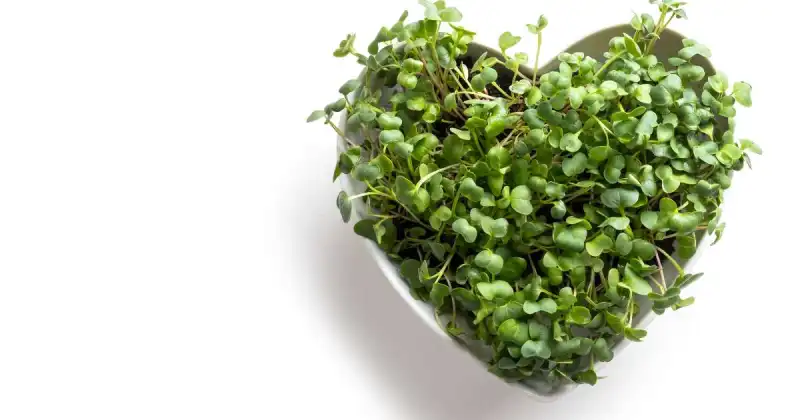
Because microgreens have a longer growing time, they tend to be larger and longer than sprouts. When fully mature, microgreens can range from 3 to 7 inches tall, depending on the variety, while sprouts generally reach only about 1 to 3 inches long when ready.
Most microgreens typically take about 1 to 3 weeks before they’re ready for harvesting. Sprouts are shorter still and are usually ready within a few days to 1 week after the germination process begins. While both provide flavor, due to their slightly longer growing cycle, micros tend to have deeper, more refined tastes. 5
Ultimately, the critical differences between microgreens and sprouts are the growing process and the plants’ size, flavor, and color when ready to be consumed.
Because the growing time for microgreens and sprouts is so astonishingly short, any mold or bacteria that takes hold in either crop should be addressed and treated immediately.
If you are still determining if you have treated these diseases adequately, discard your baby plants and start again. It’s always better to err on caution than risk consuming a food-borne illness. Luckily, because of the short growing cycle, you’ll only need to wait another week or two to harvest your new batch if you need to start over.
Microgreens vs Sprouts – Nutrition And Health Benefits
There are several nutritional and health benefits of sprouts, including:
- Potassium
- Iron
- Zinc
- Magnesium
- Copper
- Antioxidants
- Fiber
- Vitamin C
- B vitamins
- Boost immune system

Let’s look closer and review the health benefits of both microgreens and sprouts.
Microgreen Health Benefits
Microgreens such as kale, arugula, and broccoli contain higher concentrations of vitamins and minerals than sprouts, making these greens an easy and tasty way to incorporate more nutrition onto you plate and into your life. 6
In addition to high levels of vitamins and minerals, microgreens offer antioxidant properties from phytonutrients like carotenoids and flavonoids. These antioxidants may help reduce inflammation and decrease the risk of heart disease and cancer.
Another chemical found in cruciferous vegetables such as broccoli is sulforaphane, which is similarly found in elevated concentrations in broccoli microgreens. Sulforaphane is most active when chewing raw vegetables, which is why it is often lost when cooking standard veggies on the stovetop or microwave.
Some research has shown sulforaphane to have potential anticancer properties, support heart health, have anti-diabetic effects, and may potentially help other conditions.

Health Benefits Of Sprouts
Sprouts also offer a range of related health benefits due to their high concentration of vitamins and minerals. Sprouts are especially rich in B vitamins like folic acid (vitamin B9) which is essential for promoting overall well-being and helps with cell growth and metabolism, forming red blood cells, and fighting anemia.
Sprouts are also an excellent source of dietary fiber and plant proteins to help maintain healthy cholesterol levels while providing welcome energy throughout the day.
Both microgreens and sprouts provide vital nutrients that play a crucial role in supporting your overall health. However, research indicates that microgreens may be more beneficial with higher nutrient content. Either way, incorporating micros and sprouts into your daily diet provides a welcome boost of healthful goodness.
Flavor Difference Between Microgreens And Sprouts
A main difference between microgreens and sprouts lies in their flavor. Due to their different harvest time, microgreens are bigger, taller, and more mature, giving them more pronounced flavors than sprouts.
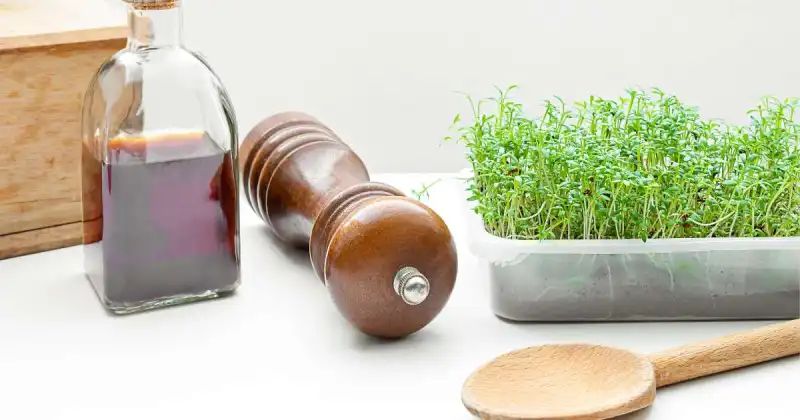
Microgreens generally have a milder flavor than their full-grown counterparts you’d see in the backyard garden, although some varieties, such as radish microgreens, may be pretty spicy.
Sprouts, too, have a mild flavor that is sometimes described as grassy, although not all varieties exhibit this characteristic. In addition, sprouts tend to be crunchy due to their high moisture content, which makes them ideal for adding texture and flavor to salads or sandwiches, among other dishes.
Are Microgreens Safer Than Sprouts
Microgreens are generally considered a safer option than sprouts, as the growing process for microgreens is usually more controlled and less susceptible to contamination. However, soaking seeds for microgreens or sprouts in room temperature water provides an excellent opportunity for environmental conditions for the growth of bacteria and mold. In this regard, sprouts are notorious for harboring dangerous bacteria such as Salmonella.
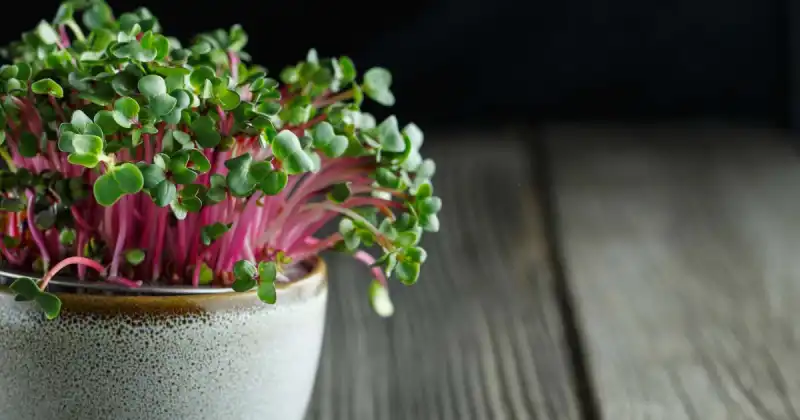
As with all vegetables, following proper hygiene and food safety guidelines is essential when growing and handling microgreens and other vegetable produce from home.
As I mentioned above, sprouts are typically linked to more cases of food poisoning when eaten raw than microgreens. This occurs because sprouts are usually grown in warm and wet environments, making them more susceptible to bacteria growth. 7
Homegrown sprouts and microgreens are much safer to eat raw than store-bought, as long as you follow the directions and instructions on your seed packets. As the home gardener, you are responsible for the entire growing process, from sanitizing the tools to providing the optimal growing environment. As a result, when you keep everything in-house, you can keep a better, more observant eye on your tiny plants, from germination to final harvest.
Conclusion
There are many similarities between microgreens and sprouts which is likely the leading cause of confusion between them. Although being similar, micros and sprouts differ in their growth, nutrient density, content, taste, and appearance.
The most significant difference between them is the growing process and harvesting time. Sprouts have a short, one week grow to harvest period and can grow without soil. Harvesting microgreens may take up to several weeks, depending on the variety you’re growing. Microgreens also require a growing medium such as soil, coco coir, or grow mat.
Although sprouts and microgreens differ in the number of vitamins and nutrients each variety offers, each makes a perfect addition to smoothies, soups, juice, pizza, or sandwiches.
Unfortunately, because of their short germination time, sprouts and microgreens are susceptible to mold and bacteria, which can devastate your entire crop. Although research has found that sprouts seem more open to harmful bacteria, your result largely depends on the quality of seeds, your growing process, and the proper sterilization of your tools and equipment.
With some practice, microgreens and sprouts are easy to grow at home, regardless of your space. Plus, you can grow them year-round and provide you and your family with excellent, homegrown nutrition.
SOURCES
- National Library Of Medicine, National Center For Biotechnology Information – Sprouts vs. Microgreens As Novel Functional Foods: Variation Of Nutritional And Phytochemical Profiles And Their In Vitro Bioactive Properties
- Purdue University, Extension – The Skinny On Microgreens Part 1
- Heart.org – Tiny Sprouts Provide Big Nutrition
- Colorado State University, Food Science And Human Nutrition – Sprouts vs. Microgreens
- Clemson University, Cooperative Extension – The Food Safety Of Sprouts Factsheet
- Penn State University, Extension – Production And Harvesting
- Wikipedia – Sprouting



